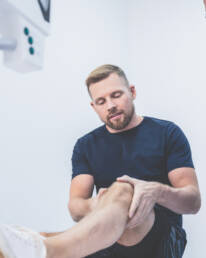
Welcome to Denver Sports Massage, where we are committed to providing you with the most effective and innovative treatments to help you reach your full potential. We are excited to introduce you to the world of Kinesio Taping, a cutting-edge therapy that has gained widespread recognition for its effectiveness in addressing various sports-related issues. In this comprehensive guide, we will explain the science behind Kinesio Taping, its benefits, and why Denver Sports Massage is your best choice for this remarkable treatment.
What is Kinesio Taping?
Kinesio Taping is a specialized treatment method that involves applying a unique, elastic adhesive tape to the skin to support and stabilize muscles, joints, and other soft tissues. Developed by Dr. Kenzo Kase in the 1970s, Kinesio Taping has become an essential therapy for athletes and active individuals worldwide.
This innovative taping technique is designed to facilitate the body’s natural healing processes while providing support and stability to muscles and joints without restricting the body’s range of motion. The elastic properties of the Kinesio Tape work in harmony with your body’s biomechanics, providing you with a dynamic, therapeutic approach to recovery and performance enhancement.
How Does Kinesio Taping Work?
The science behind Kinesio Taping is rooted in its unique ability to interact with the body’s sensory and mechanical systems. The Kinesio Tape is made of a highly elastic, latex-free material that mimics the qualities of human skin. When applied correctly, it can:
- Stimulate sensory receptors in the skin: The gentle lifting action of the tape activates sensory receptors in the skin, which in turn sends feedback to the brain. This improved proprioception (awareness of the body’s position and movements) can result in better muscle activation, coordination, and overall performance.
- Enhance lymphatic drainage and blood circulation: By lifting the skin and creating micro-channels between the tape and the skin, Kinesio Taping encourages the efficient flow of lymphatic fluid and blood, reducing inflammation and promoting faster healing.
- Provide support and stability to muscles and joints: The tape’s elastic properties allow it to stretch and recoil like a muscle, providing external support and stability without limiting the range of motion.
- Reduce pain and discomfort: The gentle pressure applied by the tape can help alleviate pain by reducing the pressure on pain receptors in the skin, as well as providing structural support to the affected area
Benefits of Kinesio Taping
Kinesio Taping offers a range of benefits to help you achieve your performance and recovery goals, including:
- Pain relief: Kinesio Taping can provide immediate and long-lasting relief from acute and chronic pain associated with various musculoskeletal conditions, such as tendonitis, sprains, strains, and muscle imbalances.
- Reduced inflammation and swelling: By promoting lymphatic drainage and circulation, Kinesio Taping can help reduce swelling and inflammation, speeding up the healing process.
- Enhanced athletic performance: Kinesio Taping can improve muscle activation, coordination, and overall proprioception, leading to better performance in sports and physical activities.
- Injury prevention: By providing support and stability to muscles and joints, Kinesio Taping can help prevent injuries and re-injuries, allowing you to stay active and healthy.
- Improved postural alignment: Kinesio Taping can be used to correct postural imbalances and muscle weaknesses, leading to improved biomechanics and reduced strain on the body.
- Faster recovery from workouts and competitions: The enhanced blood flow and reduced inflammation provided by Kinesio Taping can help speed up the recovery process, allowing you to bounce back faster from intense physical activities.
- Increased range of motion: Unlike traditional athletic tape, Kinesio Tape does not restrict movement, allowing you to maintain your full range of motion while still benefiting from the tape’s support and stability.
Who Can Benefit from Kinesio Taping?
Kinesio Taping is a versatile treatment method that can benefit a wide range of individuals, including:
- Athletes: From weekend warriors to professional athletes, Kinesio Taping can help optimize performance, prevent injuries, and support recovery.
- Individuals recovering from injuries or surgeries: Kinesio Taping can be an essential part of the rehabilitation process, providing support and stability to healing tissues while promoting efficient circulation and lymphatic drainage.
- People with chronic pain and musculoskeletal conditions: Kinesio Taping can help alleviate pain and discomfort associated with conditions such as arthritis, tendonitis, and chronic muscle imbalances.
- Pregnant women: Kinesio Taping can provide support to the growing belly, reducing discomfort and strain on the lower back and pelvic area.
- Individuals with postural issues: By addressing muscle weaknesses and imbalances, Kinesio Taping can help improve posture and alignment, reducing the risk of pain and injury.
Why Choose Denver Sports Massage for Kinesio Taping?
At Denver Sports Massage, we are dedicated to providing the highest quality Kinesio Taping services to help you achieve your performance and recovery goals. Here’s why we should be your top choice for Kinesio Taping:
- Expertise: Our highly trained and experienced therapists are certified in Kinesio Taping, ensuring that you receive the most effective and precise application of the tape.
- Customized treatment plans: We understand that every individual has unique needs and goals. Our therapists will assess your specific situation and develop a customized Kinesio Taping plan tailored to your requirements.
- Comprehensive approach: At Denver Sports Massage, we believe in a holistic approach to wellness. Our Kinesio Taping services are designed to complement our other offerings, such as sports massage, deep tissue massage, and flexibility training, ensuring that you receive comprehensive care to support your overall well-being.
- State-of-the-art facilities: Our clean, comfortable, and modern facility is equipped with the latest tools and technologies to provide you with the best possible Kinesio Taping experience.
- Exceptional customer service: Our friendly and knowledgeable staff is committed to providing you with exceptional service, making your visit to Denver Sports Massage a positive and enjoyable experience.
Schedule Your Kinesio Taping Appointment Today
Kinesio Taping is a powerful and versatile treatment method that can help you unlock your full potential, whether you’re an athlete seeking peak performance, an individual recovering from an injury, or someone looking to improve their overall well-being. At Denver Sports Massage, we’re proud to offer expert Kinesio Taping services that can be tailored to your specific needs and goals. Contact us today via phone (303) 630-9603 or access online anytime to schedule your appointment and experience the benefits of Kinesio Taping for yourself.


